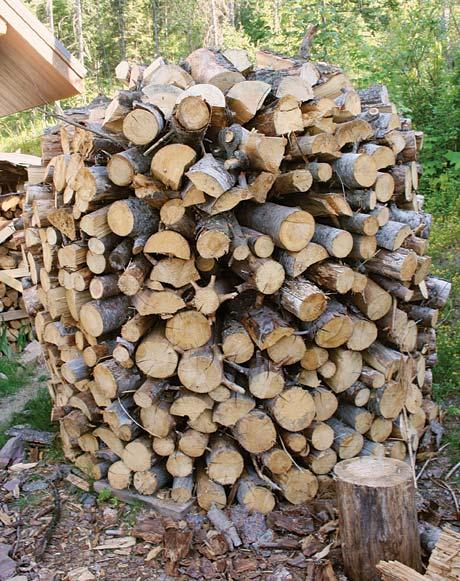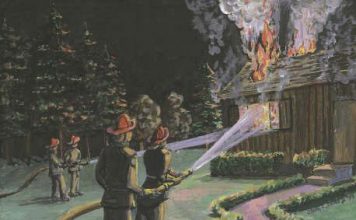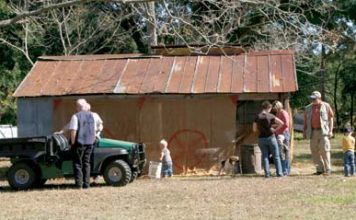| Issue #132 • November/December, 2011 |
My secret passion is tall, dark, and handsome. I may find her lying luxuriantly among a dark grove of firs. She may be standing proudly on a sunny mountainside with flowers at her feet, waiting for me to arrive for a secret rendezvous in the woods just me, a dead tree, and my chain saw.I have a confession to make: I’m in love.
Yup, I love firewood.
I love every aspect of the firewood scene. I love dropping a dead tree among its lush green neighbors, leaving more light and air for healthy trees to grow. I love blocking the wood up and splitting it, an art that takes a little bit of muscle and a lot of skill. I love to see wood dry over the season, watching it darken from the creamy yellow of fresh-cut wood to the browned and cracked ends of a well-dried log. I love the exercise that comes from working with wood (not to mention my farmer’s tan stand back, ladies); and the few ashes I gather monthly form a dandy ice-melt for the driveway or fertilizer for the garden. I love starting the 200th fire of the season almost as much as I love starting the first; and as for the bone-soaking heat of a wood fire, the faint perfume of woodsmoke in the winter air, the magic of embers in the night well, you won’t get those with your forced-air gas furnace, no matter what its website says.
There’s another aspect of woodburning that almost drives my cheapskate heart giddy with delight. Firewood is cheap heat. If you live near the woods and can get it yourself, it’s ridiculous how little you can spend to keep your tootsies toasty all winter long. Even if you have to buy your firewood, a well-insulated home stretches that wood a long way. Last year in our neck of the woods, we enjoyed one of the longest, snowiest winters on record. I went through more than five cords of wood. The cost: $20 for a permit to cut wood, $75 for chain saw maintenance, and $50 or so for transportation, chain saw fuel, oil, and various supplies. That’s $145 for eight months’ worth of heat. You won’t get that with hydronic heat in your floor, no matter what the neighbors say.
|
I have another confession to make: When it comes to stacking firewood and keeping it stacked, I have a checkered past. I’m not too good at stacking up my winter’s heat and keeping it there. Up where we live, the summers are short. The brief time available for drying wood leaves little room for restacking toppled woodpiles. Wood shrinks as it dries. It shifts and cracks, and knots and broken branches become fulcra that slowly tilt the stack. Bark dries out and slips loose under the pressure of stacked logs. Wind pushes on the stack. And every so often, I would come out to find that my carefully stacked line of logs has toppled down onto the ground. Not good!
I came across a traditional Old World method of drying firewood and decided to try it. After all, some of those folks live well up north and probably know a thing or two about stacking wood. It’s a circular woodpile called a holz hausen (German for “round house”). The holz hausen is started with carefully stacked wood on the exterior, loosely filled with wood blocks, tied together with interior cross poles, and topped with “thatched roof” circles of split wood. I love the results.
|
Efficiency
One boast of the holz hausen is that it dries wood more quickly than a traditional woodpile. The theory goes that its cylindrical form causes a chimney effect, in which air entering the holz hausen is drawn upward by the heated mass of wood in the center, speeding the drying effect. My experience backs up this theory. We live in an area that has short summers and is typically wet and cold in the spring, and our wood does not have much opportunity to dry out. Nevertheless, with only a few weeks’ worth of drying time I have seen very green wood in a holz hausen dry out until it cracks. With a few months of hot weather, even wet wood dries to a cracking dry state, perfect for winter burning. When it reaches that stage, I move it into the woodshed where it’s stored for the season.
Stability
Circles are naturally stable. Ever wonder why bubbles, tanker trucks, or water drops are round? It’s because the circle exerts equal pressure on all sides. No part is weaker than any other. That’s not the case with a line, which is vulnerable along its length; the longer it gets, the more vulnerable to pressure. That’s as true with woodpiles as it is with geometry.
The circular form of a holz hausen means that every block of wood exerts roughly equal pressure on every other block at its level. The blocks help hold each other in place. If the wood is stacked carefully, the holz hausen not only retains its shape as the wood shrinks, it actually becomes stronger as the individual pieces settle in together, grabbing on to each other and to the cross pieces inside.
Space conservation
A wood stack for one cord of wood 128 cubic feet is not much problem if you have limited space. But if you heat with wood, finding room for five to eight cords of wood to dry out over the summer or over a year, if necessary becomes more of a problem. We built our home on a fairly steep mountainside, and level spots are hard to come by. Every summer I had long stacks of firewood down by the garden, up by the house, and wherever I could fit it. When I strung out a Great Wall of Firewood along the driveway, my wife drew the line. Three or four handsome cylinders of wood out back are a much better use of space.
Beauty
That brings us to another benefit of the holz hausen: They’re nice to look at. Everyone who sees our wood stacks comments on their unexpected shape, often followed by something like, “You know, that’s kind of pretty.” Something about the snug, compacted shape suggests the very snugness that the firewood will create when the snow begins to fall.
|
Building a holz hausen
Start your holz hausen on level ground, with maximum exposure to sun and wind. Cover the ground with gravel or a thick layer of bark, or some other material to keep your firewood away from the moisture in the soil. Pound a stake into the ground, and tie a string around it. Cut the string off four feet from the stake, and knot it to prevent unraveling. This is your measuring string the radius of the holz hausen.
At the end of the string, place a small piece of flat wood at right angles to the string. I use scrap lumber sawn about 18 inches in length. Next to that flat piece place another one, whose center is also perpendicular to the string. These pieces of wood form the outside radius of your holz hausen, and also keep its outside edge tipped inward. Move around the circle, placing wood pieces; the string keeps your radius constant, forming a circle about eight feet in diameter. Depending on the height of the stack and how tightly you stack it (you don’t want it too dense, you want the air to move through it), your holz hausen will hold about a cord and a half of wood.
Begin stacking your firewood with the outside of each block aligned with the far end of your measuring string. This way, your beginning row of blocks will be tilted in toward the center, helping ensure the stability of your stack.
You’ll soon notice that the natural tendency of the wood is to tilt outward, not inward. That’s because the blocks of wood, being roughly rectangular, will radiate from the center point of the circle like the petals of a flower. This causes V-shaped gaps opening outward between each block of wood. The wood above the gaps wants to settle into them, tipping the wood blocks outward and weakening the stack. This is the single biggest challenge of building a holz hausen (really, it’s the only one I can think of). You’ll need to battle this tendency with your ingenuity and a bit of care, but since you are smarter than a block of wood, it’s not hard to do.
One way to keep your wood always tilted inward is to make sure that the fat part of every block is on the outside of the circle. This extra width may be caused by knots or broken branches sticking out of the block; also, split pieces will often flare around a large knot, causing one end to be wider than the other. You can use a smaller-diameter piece of wood to wedge into a pesky gap to maintain your angle. I have also found that shifting a piece so it’s slightly diagonal to its neighbors will often cause its inside end to drop down, which is what I want.
You can also prop up a sagging block with a smaller stick placed perpendicular to it, to boost its drooping ends. Just make sure that your prop log goes in split side down, so that it isn’t forced out under pressure.
When the stack is about three feet high, place two 8-foot cross poles right across the stack. I make these from natural wood poles I cut from my property. Place them at right angles to each other, and make sure the ends are aligned with the outsides of the blocks. This will help hold the holz hausen together as it rises. Place a second set of cross poles between the 5- and 6-foot levels, and continue stacking at least two more feet of blocks above this to hold it steady.
Once there’s enough weight on the first set of cross poles to hold it in place, you can begin tossing wood blocks of firewood loosely into the center (some people suggest that you can stack it vertically there). The substrate of gravel or bark will keep these blocks from ground moisture, and their loose configuration will help allow air penetration through the entire stack.
This inner woodpile serves two purposes. One, its bulk helps hold the mass in place and increases its stability even further. Two, it allows you to dry more wood in the same area than if the holz hausen were hollow. I like to throw drier pieces into the center. This reduces the total amount of moisture that needs to be removed from the stack, and ensures that if the drying process is slower than anticipated, I still have well-dried wood in the center.
Finish your holz hausen by first heaping up the loose center pieces to form a mound. Then, on top of your top circle of wood, complete a circle of blocks split in half with the bark still on. Create a second tier of similar blocks inset 8-12 inches in from the first circle, and a third circle in from the second. These circles will begin climbing the mound you made as you move inward, raising inner tiers above outer tiers. Continue to shrink your circle right into the center. This will give you a “thatched roof” top to your holz hausen. Bark is waterproof, so this covering will shed much of the precipitation that may fall on your stack during the summer. The rising concentric circles finish off your holz hausen nicely.
As for drying wood efficiently, I’m hooked. The holz hausen does a great job of reducing fresh, wet wood to crackin’ dry fuel in reduced time, and its handsome and sturdy shape ensures that everybody who sees it knows all about my love affair with wood heat.


















I live in the NEK (Northeast Kingdom) of Vermont and have typically used row stacking. This was the 2nd year of using a Holz Hauzen and I’m going back to row stacking cross-wind. Even through I modified the build with a vent pipe through the center and the stack sits on a southern exposed clear hill exposure, the stack doesn’t breathe in moist climates promoting mold and rot accumulation. Granted, It’s more stable than rows but it seems to become more of a moisture trap. I’m debating on just using some TPosts and High Fence to create a catch bin on pallets then toss everything in there as an experiment. A few of FB wood stoves groups have commented that that approach was a) simpler to the task abd that the gapping promted better airflow. Best Wishes
To Eric, as above: The article stated the wood house functions to dry wood, or to season it. After which it is stacked under shelter to stay dry for winter use.
Holz= wood, Hausen= Houses, in High German and most dialects of German.
Well written except that it perpetuates the online myth of “round house ” firewood stacking dries wood faster than other methods it doesn’t. Round stacking is a traditional way to store already dried firewood in parts of Europe where space is a concern, not to dry it. Stacking firewood where the ends are not exposed to air flow increase drying time.
I had a half chord of wood stacked when delivered, and it fell over. I decided to build a holz hausen with the wood instead of stacking it back up because the wood is very green and wouldn’t burn well when I tried recently.
Unfortunately I don’t know how big of a circle I’ll need, but throwing extra wood inside the hausen should help if I have some left over and keep me from needing to be exact with the diameter. I’ll try to remember to come back here and report how well it works and what size I end up with.
Good write-up about this wood stacking method. One minor correction — Holz is German for wood, not round. So Holz Hausen translates to Wood House.
Great article – thanks! I heat with wood for about 8 months so this should be a great storage system. Quick question – when you pull the wood out to use, is there a system to prevent the top from collapsing – or is it pretty obvious?